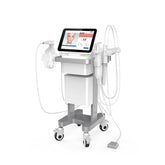A scientific guide to tattoo removal machines: Learn about the principles and technology of laser tattoo removal
Tattoos are widely popular around the world as a form of art and self-expression. However, over time, more and more people choose to remove tattoos that no longer fit their aesthetic or lifestyle. Laser tattoo removal machines have become the most popular method of tattoo removal due to their high efficiency, safety and precision. This article will introduce the working principle, classification, advantages and potential risks of tattoo removal machines in detail to help you better understand this process.
1.Working principle of tattoo removal machine
Laser tattoo removal machine mainly treats the pigment particles in the tattoo by emitting high-energy pulsed beams. Lasers of different wavelengths can be absorbed by inks of different colors. When the laser irradiates the tattoo area, the pigment particles in the ink absorb the light energy and expand rapidly, and then are broken down into smaller particles. These particles are eventually gradually removed through the human body's lymphatic system to achieve the effect of tattoo removal.Here's a basic look at how laser tattoo removal works:
Laser emits pulsed beams: The laser device emits a high-energy pulsed beam of a specific wavelength directly onto the tattooed area on the surface of the skin. Different colors of tattoo ink absorb different wavelengths of laser light.
Pigment absorbs the laser: The pigment particles in the tattoo absorb the energy of the laser. This energy heats the pigment particles and causes them to expand rapidly.
Pigment breaks down: Under the action of the laser, the pigment particles are broken down into smaller particles. These particles are much smaller than the original pigment particles and are more easily removed by the body naturally.
Body removes pigment: The broken down pigment particles are gradually removed through the body's lymphatic system and eventually metabolized by the immune system. This process usually takes several weeks.
Multiple treatments: Because tattoos vary in color and depth, it usually takes multiple laser treatments to completely remove a tattoo. After each treatment, the color of the tattoo gradually fades until it disappears completely or becomes almost invisible.
The effectiveness of laser tattoo removal depends on the color and depth of the tattoo, the type of ink used, and the patient's skin type. Different laser models and wavelengths can better handle different colors and tattoo types. Common laser devices include Q-switched Nd lasers and picosecond lasers.
2.Classification of tattoo removal machines
Tattoo removal machines mainly use laser technology to remove tattoos. Tattoo removal machines can be divided into several main types based on the type of laser, wavelength and pulse duration:
(1)Q-Switched Laser
This is the most common laser technology for tattoo removal, which breaks down tattoo pigment by rapidly releasing high-energy pulses. Q-switched lasers can be further subdivided into the following categories:
Q switch Nd
Laser: This is the most common laser for tattoo removal. It uses two wavelengths, 1064nm and 532nm. The 1064nm wavelength is most effective for dark inks such as black and blue, while the 532nm wavelength is more suitable for light inks such as red and orange.
Q-switched Ruby Laser: Uses 694nm wavelength, suitable for removing lighter blue, green and black inks. This laser is very effective on light-colored and old tattoos, but is used less frequently because of its shorter wavelength and higher risk of damage to the skin.
Q-switched Alexandrite Laser: Uses 755nm wavelength and is suitable for removing green, blue and black tattoos. Due to its deeper penetration of skin pigments, the effect is significant, but it has a higher risk of pigmentation on light-colored skin.
(2)Picosecond Laser
Picosecond laser is a newer tattoo removal technology that has a shorter pulse duration (picosecond level) and therefore breaks down pigment particles faster. For example,Newangie 3 In 1 diode Laser YAG IPL Beauty Machine.
Picosecond lasers also come in different wavelengths, typically including:
Picosecond Nd
Laser: Uses 1064nm and 532nm wavelengths, similar to Q-switched Nd
Laser, but because the pulse time is shorter and the pigment is broken down more completely, the number of treatments is usually fewer.
Picosecond Alexandrite Laser: Using 755nm wavelength, it specifically targets blue, green and black tattoos, with higher efficiency and fewer side effects.
(3)Carbon dioxide laser (CO2 Laser)
Carbon dioxide lasers are not specifically designed to remove tattoos, but are sometimes used as an adjunct to treat stubborn tattoos. This laser removes pigment by evaporating the top layer of skin while helping to reduce scarring. It is primarily used for shallow tattoos or in combination with other laser technologies.
(4)Laser dye system (Pulsed Dye Laser, PDL)
Laser dye systems typically use 585nm or 595nm wavelengths and were originally used to treat vascular disease, but can also be used to remove red and orange tattoos. Because its wavelength absorbs red pigment well, it is sometimes used when treating tattoos of these colors.
(5)Non-laser technology
Although not classified as laser tattoo removal machines, there are other types of tattoo removal equipment:
Dermabrasion: Removes tattoos from the skin surface through mechanical grinding. However, it is rarely used due to its high invasiveness, high risk and tendency to leave scars.
Surgical Excision: For small tattoos, the tattoo is surgically removed directly from the skin. This method is suitable for small area tattoos, but it will leave scars.
Summarize
Modern tattoo removal relies heavily on laser technology, with Q-switched lasers and picosecond lasers being the most common and effective options. Different types of lasers target different tattoo colors and skin types, each with their own unique advantages. Choosing the right laser model can improve removal results and reduce side effects.
3.Advantages of tattoo removal machine
Tattoo removal machines, especially laser tattoo removal technology, have several advantages over other tattoo removal methods:
(1)High efficiency
Highly targeted: The laser can accurately target the pigment particles in the tattoo, especially multi-color tattoos, and can effectively remove ink of multiple colors.
Gradual fading: After each treatment, the tattoo will gradually fade and eventually achieve the desired effect. It can achieve good removal results for light, dark or multi-color tattoos.
(2)Safety
Non-invasive: Laser removal is non-invasive and does not require cutting the skin, so the risk of infection is low.
Minor damage to surrounding tissues: The laser energy is mainly concentrated on the pigment particles of the tattoo, causing less damage to the surrounding normal skin tissue.
(3)Precise control
Adjustability: The energy, wavelength and pulse time of the laser can be adjusted according to the color, depth and size of the tattoo to ensure the best treatment effect.
High adaptability: It is suitable for most types and parts of tattoos and can handle complex and delicate patterns.
(4)Less scar risk
Reduce scars: Compared with traditional tattoo removal methods (such as surgical excision or grinding), laser removal is less likely to produce scars.
Gradual recovery: The skin will usually return to its normal color and texture within a few weeks, with a low risk of scarring.
(5)Quick recovery
Short recovery time: The recovery time after treatment is usually only a few days, and most people can return to their daily activities within a few days.
Minimal downtime: Due to the non-invasive operation, patients can return to normal work and life immediately after treatment.
(6)Wide application
Suitable for a variety of skin types: Modern laser technology has been developed to be able to treat different types and colors of skin, with a wider range of applications.
Removal of tattoos in multiple colors: Lasers with different wavelengths can effectively remove tattoos in multiple colors such as black, blue, red, green, etc.
(7)Selective
Gradual removal: If the patient only wants to remove part of the tattoo or a specific color, laser removal can achieve precise selective removal.
(8)Advanced technology
Picosecond laser: The latest picosecond laser technology can break down pigment particles faster and more thoroughly, reduce the number of treatments, and improve the removal effect.
Overall, tattoo removal machines (especially laser technology) have become the most popular tattoo removal method due to their efficiency, safety and precision.
4.Risks and side effects of tattoo removal
Laser tattoo removal machines are generally considered safe when performed professionally and used correctly, but there are some potential risks and side effects to consider:
Potential Risks and Side Effects:
Skin Irritation and Redness: After laser treatment, your skin may experience temporary redness, swelling, and irritation, similar to a mild sunburn. This usually subsides over a few days.
Pigmentation Changes: Some people may experience hyperpigmentation or hypopigmentation, a darker or lighter coloring of the skin, after laser treatment. This condition is usually temporary, but in a few cases it can be permanent, especially in people with darker skin tones.
Scarring: Although rare, laser treatments can cause scarring, especially if the skin becomes infected or not properly cared for after treatment.
Risk of Infection: If the treated skin is not properly cared for, it may develop an infection. Keeping the treated area clean and following your doctor's care recommendations can reduce this risk.
Pain and Discomfort: During and after laser treatment, you may experience pain or discomfort, similar to the feeling of being hit by a rubber band. This discomfort can usually be reduced with a local anesthetic or cooling device.
Generally speaking:
Professional operation: Laser tattoo removal is relatively safe if it is performed by a trained professional and with the appropriate laser equipment.
Suitable for everyone: Not everyone is suitable for laser tattoo removal, especially those with certain skin diseases or light sensitivity. It is recommended to consult a dermatologist or professional practitioner before treatment to determine whether it is suitable for treatment.
Long-term effects: So far, there is no evidence that laser tattoo removal has long-term harmful effects on the body. Side effects during treatment are usually short-lived and can be managed with proper care.
In general, laser tattoo removal is currently the most commonly used method of tattoo removal, and it is relatively safe when properly performed.
5.Conclusion
Laser tattoo removal machine has become the preferred method for tattoo removal due to its high efficiency, safety and precision. Whether it is due to a change in personal aesthetics or a professional need, laser technology can provide you with a relatively safe and effective way to remove tattoos. Before deciding to undergo laser removal, it is recommended to consult a professional to understand the type of laser that is suitable for you and the possible treatment effects.
With proper operation and care, most people can achieve satisfactory tattoo removal results after laser treatment while maintaining the health and beauty of their skin.






Leave a comment
All blog comments are checked prior to publishing